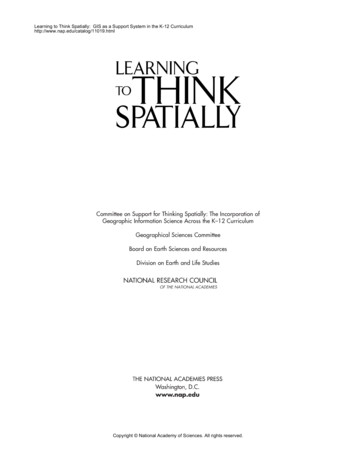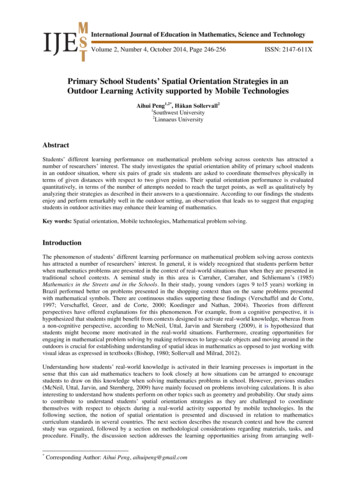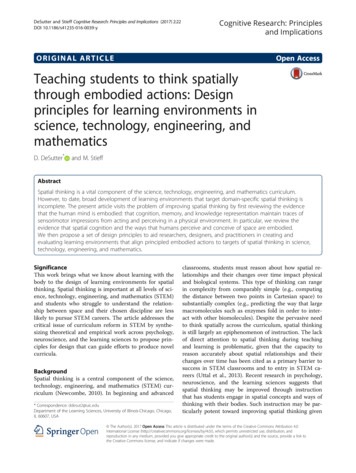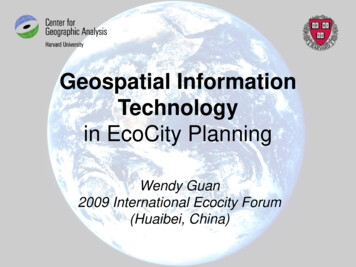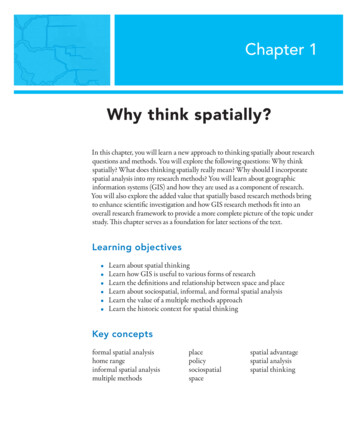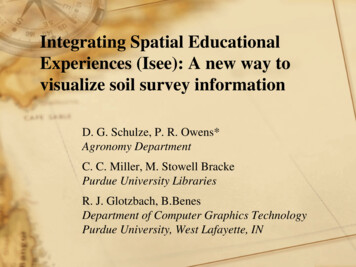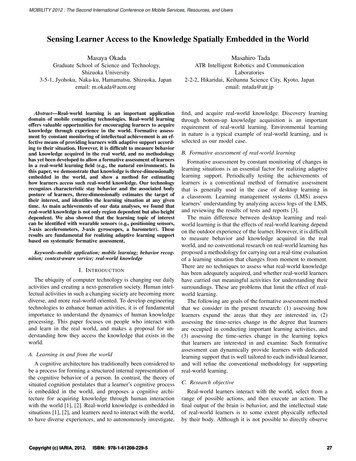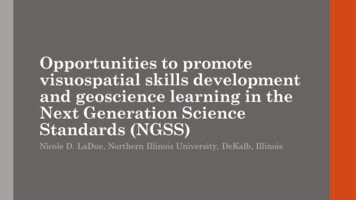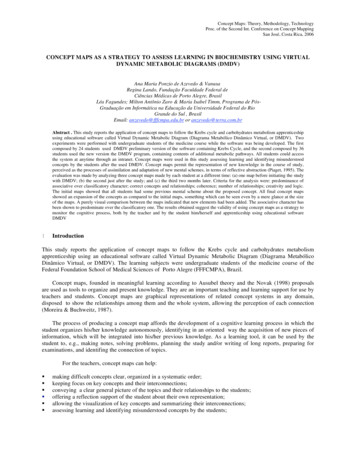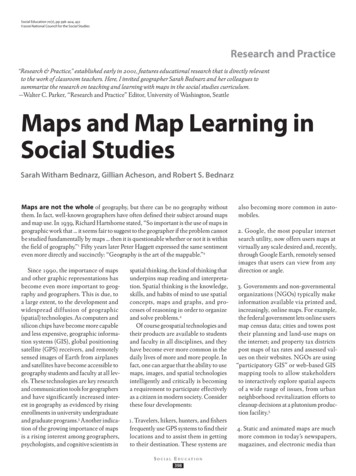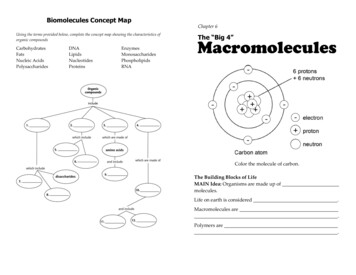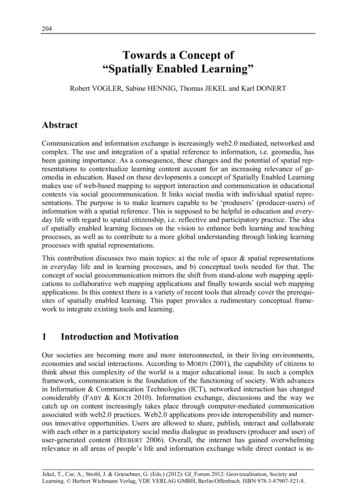
Transcription
204Towards a Concept of“Spatially Enabled Learning”Robert VOGLER, Sabine HENNIG, Thomas JEKEL and Karl DONERTAbstractCommunication and information exchange is increasingly web2.0 mediated, networked andcomplex. The use and integration of a spatial reference to information, i.e. geomedia, hasbeen gaining importance. As a consequence, these changes and the potential of spatial representations to contextualize learning content account for an increasing relevance of geomedia in education. Based on these devlopments a concept of Spatially Enabled Learningmakes use of web-based mapping to support interaction and communication in educationalcontexts via social geocommunication. It links social media with individual spatial representations. The purpose is to make learners capable to be ‘produsers’ (producer-users) ofinformation with a spatial reference. This is supposed to be helpful in education and everyday life with regard to spatial citizenship, i.e. reflective and participatory practice. The ideaof spatially enabled learning focuses on the vision to enhance both learning and teachingprocesses, as well as to contribute to a more global understanding through linking learningprocesses with spatial representations.This contribution discusses two main topics: a) the role of space & spatial representationsin everyday life and in learning processes, and b) conceptual tools needed for that. Theconcept of social geocommunication mirrors the shift from stand-alone web mapping applications to collaborative web mapping applications and finally towards social web mappingapplications. In this context there is a variety of recent tools that already cover the prerequisites of spatially enabled learning. This paper provides a rudimentary conceptual framework to integrate existing tools and learning.1Introduction and MotivationOur societies are becoming more and more interconnected, in their living environments,economies and social interactions. According to MORIN (2001), the capability of citizens tothink about this complexity of the world is a major educational issue. In such a complexframework, communication is the foundation of the functioning of society. With advancesin Information & Communication Technologies (ICT), networked interaction has changedconsiderably (FABY & KOCH 2010). Information exchange, discussions and the way wecatch up on content increasingly takes place through computer-mediated communicationassociated with web2.0 practices. Web2.0 applications provide interoperability and numerous innovative opportunities. Users are allowed to share, publish, interact and collaboratewith each other in a participatory social media dialogue as produsers (producer and user) ofuser-generated content (HIEBERT 2006). Overall, the internet has gained overwhelmingrelevance in all areas of people’s life and information exchange while direct contact is inJekel, T., Car, A., Strobl, J. & Griesebner, G. (Eds.) (2012): GI Forum 2012: Geovizualisation, Society andLearning. Herbert Wichmann Verlag, VDE VERLAG GMBH, Berlin/Offenbach. ISBN 978-3-87907-521-8.
Towards a Concept of “Spatially Enabled Learning”205creasingly augmented through and partly even replaced by media-based communicationoccurring in social media. Empirical studies show the deep involvement of young people inthe activities encouraged by the seemingly democratic and open nature of the media concerned (UNICEF 2010, LENHART et al. 2010, ACMA 2008). According to LIVINGSTONE(2008), this enthusiasm should be used as a relevant means to enhance learning (and teaching) in secondary education, but as REILLY (2011) and HAMPSON et al. (2011) suggest,policy responses usually act as inhibitors rather than enabling innovation in schools.Based on the premise that the public meaning of the internet shifted from a ‘virtual reality’metaphor in the late 90ies1 to a digital mashup of our daily life,2 that is available via mobiledevices all time and everywhere (MEYER in print), digital communication practice andinformation gathering are more and more location based. As a consequence of this digital‘rebirth of place’ and besides ‘common’ web2.0 multimedia, the production, use and integration of geomedia play a pivotal role in pluri-disciplinary, web2.0-mediated communication. Due to the appearance of applications such as digital globes (e.g. Google Earth, Virtual Earth), web mapping services (e.g. Google Maps, Bing Maps), GPS enabled mobiledevices and location based services, the public’s interest on and use of spatial data, geomedia and web maps – in a nutshell Geo-ICT – rapidly increased (THIELMANN et al. 2011).Location is used to integrate information and provides a focal point of communication inboth science and society. Consequently, in this geospatial world everyday life and communication is increasingly geo-referenced whatever the subject matter. In addition to that,spatial data, geomedia and web maps are increasingly used as – as well as seen as – important communication platforms. Today, the use of spatial data and geographic applicationson the internet is not necessarily linked to experts work, but accessible and usable by thepublic not disposing about spatial data, GIS or classical cartographic competencies. In sumwe can say that a spatially enabled society is arising recently.Based on the premise, that school education should provide relevant skills to participate insociety, these changes in our everyday life account for an increasing relevance for geomedia in education, as well (DONERT 2010). The intrusion of new (geo)communication mediarequires the development of more sophisticated (geo)communication skills. Besides severalapproaches to integrate GI skills in geography education (see, for example, various contributions in JEKEL et al. 2010, 2011), there are no recent concepts to support communicationin learning processes in general with a spatial contextualization via digital tools.2Spatially Enabled LearningSpatially Enabled Learning tries to fill exactly this gap. Thus, this situation outlined abovecan (and should) be re-adressed by exploring spatially enabled learning and teaching processes across a number of different subjects. This aims at the integration of communicationand geo-technological tools into a state-of-the-art (e-)learning framework. The availabilityand general use of web tools and location-based services can serve diverse subject areas.12I.e. ‘a second world’ or ‘the cyberspace’ or ‘virtual reality’.I.e. the internet as a digital augmentation of our personal, subjective environment; see also the“Internet of Things” vision (TUTERS & VARNELIS 2006).
206R. Vogler, S. Hennig, T. Jekel and K. DonertRelevant pedagogical approaches need to be identified that can be used across subject areas, from modern languages to humanities and sciences in secondary education.Based on these assumptions, spatially enabled learning makes use of web-based spatialrepresentations to support interaction, communication and document learning outcomes ineducational contexts by connecting complex learning content to a spatial dimension. Thiscan be achieved by contextualisation, by cartographic support of arguments in communication processes or simply as a spatialized portfolio that may be either individual or collectiveor both. Spatial representations should be both produced and used by all actors in the learning process through web2.0 possibilities including (Geo)ICT.The rationale of spatially enabled learning is furthermore based on the idea that spatialrepresentations are supposed to create a special type of “Dual Coding” (PAIVIO 1986). Thiscan be useful for both the collective production of spatial meanings (WERLEN 2010) and thesupport of learning processes via spatial contextualization of learning contents. Spatialrepresentations relate to location on the surface of the earth. They can be used for instancein digital globes and web maps, closely linked to the vision of the Digital Earth (GORE1998). There is good reason to believe that this link between analogue codes (learning contents) and symbolic codes (spatial representations) enhances the learner’s memory for complex and abstract information, as ENEMARK & RAJABIFARD (2011) in general highlight the“power of the visual over the verbal”. In pedagogic psychology, visually prepared contentshows a much wider memorability than verbal or textual issues (WEIDENMANN 2006) and isvery fruitful for educational contexts. Beyond visualizations in general, especially geovisualization and maps show a high potential to support both subjective appropriation of spaceand collaborative production of meaning (HENNIG et al. 2011). Furthermore, geovisualization and maps are constituted in a special spatio-symbolic code system that seems to beindependent from the produsers’ cultural background and goes beyond – for example –language barriers (HALL & JONES this volume). This insight is promising for a spatiallyenabled learning approach, as communicating via spatial representations may bridge learning contents beyond learners’ verbal skills and (dis)advantages.Besides such empirical results and the background of the dual coding theory, we argue thatspatially enabled learning is contingent with several other theories of learning, namelytheories of multimedia learning (MORENO & MAYER 1999). We consider spatially enabledlearning a special form of “situated learning” (LAVE & WENGER 1991) as well, includingspace as an additional reference system to socially situated learning environments. Thismay be argued by thinking of space in a constructivist version, which allows for an additional system of reference of coding in communication processes.3“Social Geocommunication” as the Backbone of SpatiallyEnabled LearningThis idea of the support of communication by subjective spatial representations derivesfrom GEOKOM-PEP (Geovisualization and communication in participatory decision making processes) (VOGLER et al. 2010), an Austrian research project that aimed to enhancecommunication skills of young people in the framework of participatory planning processes. A communication platform integrating web mapping tools and social networking
Towards a Concept of “Spatially Enabled Learning”207services has been developed to generate ‘value-added’ spatial communication among pupilsand teachers in a planning process making use of geovisualization. Thus, GEOKOM-PEPsupported collaborative decision making in spatial planning scenarios. As a result of thesecommunication forms, which include the possibilities to integrate information with a spatialreference, the concept of social geocommunication has been developed, linking social media with individual spatial representations (HENNIG et al. 2011). Geocommunication (incollaborative planning) so far has been characterized by the use and combination of a multitude of available multimedia and geomedia by high numbers of participants and featuresenabling user interaction (BRODERSEN & NIELSEN 2006). Besides producing and integratinggeomedia and multimedia, social(!) geocommunication – as an online process – also requires integrating social aspects of communication such as community building and networking. This encourages a high number of users to interactively participate in communication processes via web2.0 based tools. With regard to this definition the approach of socialgeocommunication refers to concepts closely linked to neogeography and volunteered geographic information (GOODCHILD 2007, ELWOOD 2008). Social geocommunication consequently encourages well-structured interaction and decision making between all participantsin a spatial planning scenario by the support of individually produced spatial representations, i.e. digital maps. A schematic outline of the concept of social geocommunication issummed up in Figure 1 (see below).Fig. 1:The framework of Social Geocommunication (HENNIG et al. 2011)Beyond planning scenarios, the idea of spatially enabled learning transfers this genericconcept of social geocommunication to all topics and subjects in education that have spatialreference. The approach is to implement recent social geocommunication technologies to
208R. Vogler, S. Hennig, T. Jekel and K. Donerteducation in order to support, contextualize and structure individual and collaborativelearning processes.In learning scenarios, the spatially-enabled web2.0-based communication processes can bedescribed as social geocommunication, as well. In consequence, the idea of spatially enabled learning goes beyond the spatial thinking approach (NRC 2006) that is recently discussed with regard to professional skills in GIS education and focusses on spatial analysisin the framework of absolute concepts of space. Spatially enabled learning, on the contrary,uses a constructivist understanding of space (JEKEL 2008). Meaning is always attached tospace via communication. In this context, spatial representations (like maps or geomedia ingeneral) are very powerful instruments to consolidate such socially constructed spatialmeanings (LEFEBVRE 1993). Meaning (in this case: the appropriation of learning content)accordingly can be highlighted and supported with a spatial contextualization via spatialrepresentations created by learners and/or teachers.This is supposed to be helpful in both science education and everyday life with regard to“spatial citizenship” (GRYL & JEKEL 2012). In order to incorporate spatially-enabled learning in education, new ways of teaching and learning are required and tools need to be developed to support the integration of these processes. While this idea could not be implemented in education earlier due to technical challenges and professional cartography skillsneeded, the development of (Geo)ICT and social geocommunication allows some promising new opportunities. A benefit for this is the wide range of web mapping tools freelyavailable online with that are very intuitive to use. Therefore, it is not needed to developprofessional cartography or even GIS skills to use spatial contextualization. These tools arealso characterized through combining mapping practices with the world of social networking, a pastime enthusiastically embraced by young people today. They have the potential tobe suitable for applications in learning and teaching, aiming at the integration of spatiallyenabled learning in secondary education through web mapping.4Shrinking Technical Challenges, or: “Choose your tools!”The development (and evolvement) of the social geocommunication concept mirrors theshift from (1) stand-alone web mapping applications (web mapping; cartographic communication) to (2) collaborative web mapping applications (co-operative/ participatory webmapping; geocommunication), and finally towards (3) social web mapping applications (cooperative/ participatory web mapping; social geocommunication, see Tab.1 for a first shortreview). Applications grouped under these three categories are characterized by a numberof different functionalities – implemented to a varying extent – to enable web mapping andcommunication (social networking services: constructing profile, building and maintainingsocial networks and relations, create groups, sharing information etc.).Besides the few examples mentioned in Table 1, several tools of cover prerequisites ofspatially enabled learning. These need to be put in a conceptual and practical framework.The problem here is no longer the availability and usability of such applications but more todiscover them and reasonably put them in an educational context. This challenge needs tobe adressed in the near future.
Towards a Concept of “Spatially Enabled Learning”Table 1:209Web mapping tools in terms of social geocommunication process development (state: February 2012)3Development over timeweb mapping & cartographic communicationexemplary toolsArcGIS explorer online,Google Mapscollaborative webmapping &geocommunicationScribble Maps,UMapper,Zea Mapscollaborative webmapping & s,web mappingviewingeditingsocial media services& web. 2.0 integration5ConclusionIn conclusion, the idea of spatially enabled learning focuses on the vision to enhance bothlearning processes in different subjects addressed through spatial contextualisation of learning and teaching. This may contribute to a more global understanding through linking subject-specific learning processes and localized learning outcomes. Such an approach can (1)bridge the gap between everyday social geocommunication and collaborative learning environments in education and (2) support learning processes with a special type of dual codingbeyond verbal skills or (dis)advantages. It opens the world of spatially enabled learning topupils and teachers alike and encourages the use of spatial representations in many subjectareas.Even if this main idea seems very simple (no difficult technical prerequisites, no (pre)professional GIS education, no complex competence modelling), we suggest that spatiallyenabled learning, i.e. ‘just’ linking learning processes and meanings with a spatial representation, has a high potential for innovative approaches in education. However, to use andimplement these opportunities arising from spatially enabled web2.0-based communicationin education, several topics will need to be looked at in more detail. These include: 3Which underlying concepts support spatially enabled and web2.0-based communication processes,Theoretic pedagogical concepts regarding spatially enabled learning need to be developed.Concrete pedagogies and practical pilot examples need to be created and, most notably,evaluated.Which software components and functions are required by spatially enabled web2.0based communication processes?Which tools are available (as well as suitable) for these communication processes?Due to the rapid development of freely available mapping tools and their social media integration,this overview has no empirical evidence but “just” an illustrative relevancy to show the evolutionof tools and user practices regarding “social geocommunication”. But the future development inthis domain reasonably is very fruitful and promising for the purposes stated in this paper.
210R. Vogler, S. Hennig, T. Jekel and K. DonertThese issues will be our next challenges towards a reasonable and well implemented concept of “Spatially Enabled Learning”.ReferencesACMA (2008), The Digital Media Literacy Forum. http://www.acma.gov.au/WEB/STANDARD/pc PC 311470 (accessed 15/12/2011).BRODERSEN, L. & NIELSEN, A. (2006), Spatial Data Infrastructure in the Perspective ofModern Geocommunication. Models, Mutual Dependencies and Definitions. AutoCarto2006 Research Symposium in Vancouver, WA, Jun 2006.DONERT K (Ed.) (2010), Using Geoinformation in European Geography education, Vol. IX,International Geographic Union-Home of Geography, Rome.ELWOOD, S. (2008), Volunteered geographic information: Future research directions motivated by critical, participatory, and feminist GIS. GeoJournal, 72, 173-183.ENEMARK, S. & RAJABIFARD, A. (2011), Spatially Enabled society. Geoforum Perspektiv,20 (11/2011), 3-16.FABY, H. & KOCH, A. (2010), From Maps to Neo-Cartography. In: BANDROVA, T. &KONECNY, M. (Eds.), Proceedings of the 3rd International Conference on Cartography& GIS, Nessebar.GOODCHILD, M. F. (2007), Citizens as sensors: The world of volunteered geography. GeoJournal, 69, 211-221.GORE, A. (1998), The Digital Earth. Understanding our Planet in the 21st Century. Speechat the California Science Center, Los Angeles, California, on January 31, act id 6210 (accessed 15/12/2011).GRYL, I. & JEKEL, T. (2012), Re-centering GI in secondary education: Towards a spatialcitizenship approach. Cartographica, 1/2012, 2-12.HALL, M. M. & JONES, C. B. (in print), Cultural and Language Influences on the Interpretation of Spatial Prepositions. In: JEKEL, T., CAR, A., STROBL, J. & GRIESEBNER, G.(Eds.), GI Forum 2012: Geovizualisation, Society & Learning. Berlin/ Offenbach,34-43.HAMPSON, C, CONLAN, O. & WADE, V. (2011), Challenges in Locating Content and Services for Adaptive eLearning Courses, Eleventh IEEE International Conference on Advanced Learning Technologies, ICALT 2011, Athens, Georgia, USA, 2011, 4/1/PID1756877.pdf (accessed 15/12/2011).HENNIG, S., VOGLER, R. & JEKEL, T. (2011), Web-2.0 Anwendungen zur partizipativenPlanung und Sozialen Geokommunikation. gis.SCIENCE, 1-3/2011, 65-74.HIEBERT, J. (2006), Personal Learning Environment Model, Headspace Blog ersonal-learning-environment-model.html(accessed 15.12.2011).JEKEL, T. (2008), In die Räume der GW-Didaktik. Briefe einer Reise. Wien ( Materialienzur Didaktik des Geographie- und Wirtschaftskundeunterrichts 21).JEKEL, T., KOLLER, A., DONERT, K. & VOGLER, R. (Eds.) (2010), Learning with Geoinformation V. Lernen mit Geoinformation V. Berlin/Offenbach.JEKEL, T., KOLLER, A., DONERT, K. & VOGLER, R. (Eds.) (2011), Learning with GI 2011.Implementing Digital Earth in Education. Berlin/Offenbach.
Towards a Concept of “Spatially Enabled Learning”211LAVE, J. & WENGER, E. (1991), Situated Learning. Legitimate peripheral participation. NewYork.LEFEBVRE, H. (1993), The Production of Space. Oxford/Cambridge.LENHART, A., LING, R., CAMPBELL, S. & PURCELL, K. (2010), Teens and mobile phones.Pew Internet & American Life Project, Washington DC, http://www.pewinternet.org/ 10.pdf (accessed 15/12/2011)LIVINGSTONE, S. (2008), Digital literacies: tracing the implications for learners and learning. In: ESRC seminar series: The educational and social impact of new technologies onyoung people in Britain, 21 October 2008, Graduate School of Education, University ofBristol, Bristol, UK, http://eprints.lse.ac.uk/33824/1/Digital literacies.pdf (accessed15/12/2011).MEYER, T. (in print), Das Weltweit-Werden und der umgestülpte Cyberspace. In: GRYL, I.,NEHRDICH, T. & VOGLER, R (Eds.), geo@web. Medium, Räumlichkeit und geographische Bildung. Wiesbaden, pp. pending.MORENO, R. & MAYER, R. (1999), Cognitive principles of multimedia learning. The role ofmodality and contiguity. Journal of Educational Psychology, 91 (2), 358-368.MORIN, E. (2001), Seven complex lessons in education for the future. Paris.NRC – NATIONAL RESEARCH COUNCIL (2006), Learning to Think Spatially: GIS as a Support System in the K-12 Curriculum. Washington DC.PAIVIO, A. (1986), Mental representations: a dual coding approach. Oxford.REILLY, P. (2011), 'Anti-social' Networking in Northern Ireland. Policy Responses toYoung People's Use of Social Media for Organizing Anti-social Behavior. Policy & Internet, 3 (1). ss1/art7 (accessed15/12/2011).THIELMANN, T., VAN DER VELDEN, L., FISCHER, F. & VOGLER, R. (2011), Dwelling in theWeb: Towards a Googlization of Space. Draft Paper prepared for the 1st Berlin Symposium on Internet and Society. Alexander von Humboldt Institut für Internet und Gesellschaft, Berlin.TUTERS, M. & VARNELIS, K. (2006), “Beyond locative media: Giving shape to the internetof things”. Leonardo, 39 (4), 357-363.UNICEF (2010), Mobiles4Dev Report, nation.pdf(accessed 15/12/2011).VOGLER, R., AHAMER, G. & JEKEL, T. (2010), GEOKOM-PEP. Pupil led research into theeffects of geovisualization. In: JEKEL, T., KOLLER, A., DONERT, K. & VOGLER, R.(Eds.), Learning with Geoinformation V. Berlin/Offenbach, 51-60.WEIDENMANN , B. (2006), Lernen mit Medien. In: KRAPP, A & WEIDENMANN, B (Eds.),Pädagogische Psychologie Ein Lehrbuch. 5th Edition. Weinheim, 423-476.WERLEN, B. (2010), Gesellschaftliche Räumlichkeit 2. Konstruktion geographischer Wirklichkeiten. Stuttgart.
in learning processes in general with a spatial contextualization via digital tools. 2 Spatially Enabled Learning Spatially Enabled Learning tries to fill exactly this gap. Thus, this situation outlined above can (and should) be re-adressed by exploring spatially enabled learning and t
